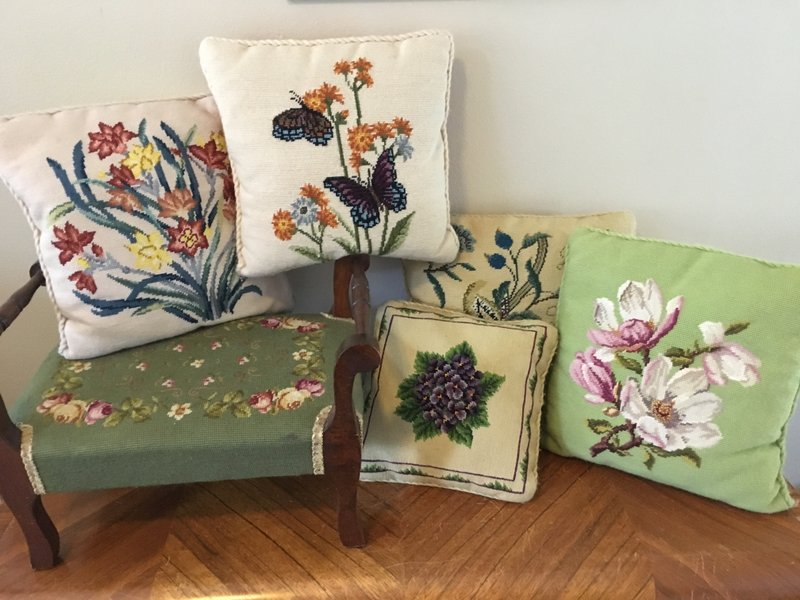"I'm up to my eyeballs in needlepoint pillows," came the text from my neighbor and friend Deborah Robison, when I asked how her mother's move was going. "I'm decluttering generations of inheritance."
I have been there, and now Deborah is. Going through a parent's belongings is a rite of passage almost none of us avoids. A task that seems straightforward on the surface grabs you by the ankles and drags you under with the uncompromising pull of a riptide.
"I just found Mom's baby shoes," came the next text. "They button up and are 97 years old!"
In she goes.
At age 98, Deborah's mother decided to move from her one-bedroom apartment to a smaller place in a community that offers more senior support.
"The move was all her idea," Deborah said the next day as we went for a walk with the dogs. "Mom has always been forward-looking and organized. And she loves the new place. The support makes her feel more secure."
More parents like this, please.
"She's just worried that clearing out her apartment will be too much trouble for me," Deborah added, waving her hand as if swatting a minor nuisance. "No, Mom. No trouble at all!" And we laughed.
The apartment, of course, tells a different story. The packed-up place is full of heavy old furniture, antiques, artwork the grandchildren made and more than two dozen needlepoint items -- stools, chairs, pillows, wall hangings -- made by Deborah's grandmother. Colored Post-It notes dot the furniture and boxes like confetti.
"Each color indicates where the pieces are going," said Deborah, the ringmaster of this three-ring circus. The blue sticker items are going on a truck heading toward Pennsylvania, where they'll be divided among family members. "Mom has already decided whom she wants to have what. I'm just executing her wishes."
Monday, another truck will pick up everything else and make four drops: Mom's new smaller place, Deborah's house, the consignment store and finally the donation center.
"The stuff that gets off the truck last goes in first," said Deborah, a recently retired marketing executive. Overwhelming as these logistics are, I knew this was the easy part. She was starting to see that, too.
"I had no idea how submerged I would get. I thought I was going to just pack and ship, but that was the least of the work. I didn't expect to take such a deep dive into the family history."
"I am walking that line between preserving the family history and not perpetuating the avalanche that compounds with each generation," she said. "I mean, I have three sets of china."
"Fortunately, mom is a great resource and can tell me why certain items have significance."
"Wait," I interrupt. "Do you know how lucky you are to have a mom who not only has a plan but who also can remember the family history? I don't have a plan for dinner and can't remember what I had for lunch."
Ever curious about how smart, thoughtful people navigate these waters, I asked Deborah about the highs, lows and findings of her downsizing journey.
Biggest shock: "How many keepsakes my mother had. She saved every birthday and Mother's day card ever sent to her. That was overwhelming."
Biggest burden: "When you inherit items that previous generations have placed great value in, it becomes instilled in you that these pieces have value (though they often don't). You feel a responsibility to find a good home for the piece and balance that against the reality that you really don't want to keep it in your house." Amen.
Best resource: Online outlets, like Craigslist, offer more avenues to sell furniture today quickly without relying on consignment stores, which are pretty selective. "Selling a piece to someone who really wants or needs it gives you the satisfaction that you've done right by the piece and by your parent," she said.
Best idea: Because she didn't want to ship items to relatives and hand pieces down to her 26-year-old twin daughters without context, she gathered facts with her mom's help, and typed notes to send along. Notes included details about the original owner, and when and why the item was used. For example, Deborah's great grandmother became a widow in the early 1900s. To support herself and her two young children, she opened a general store in Philadelphia. Customers used brass scoops to get items sold from barrels. Deborah now has one of the scoops. "Until you know how she came to open the store and why, the scoop is pretty meaningless."
Best advice: Talk to family elders now while their stories are still alive. Deborah also learned that her paternal grandmother needlepointed all those items to calm her nerves while both her sons, including Deborah's dad, were fighting World War II. "Each family member will get a pillow, which some are more enthusiastic about than others," she said. The point being, an object means more when connected to a story, and a story means more when connected to an object.
Most unexpected finding: Family members differ on how much or little they want. Some want many items; others want few, she said.
Syndicated columnist Marni Jameson is the author of five home and lifestyle books, including Downsizing the Family Home -- What to Save, What to Let Go
HomeStyle on 08/31/2019
